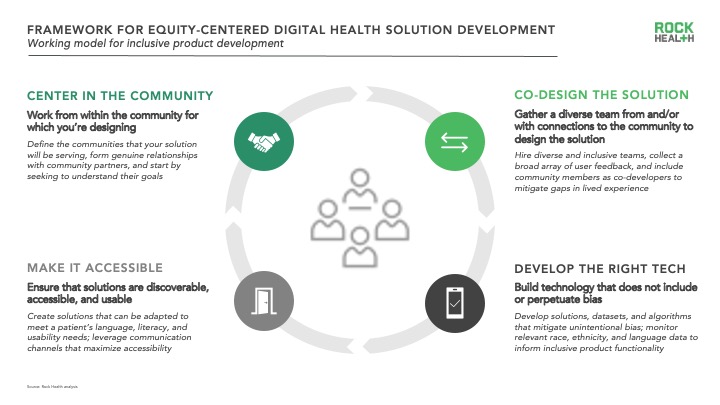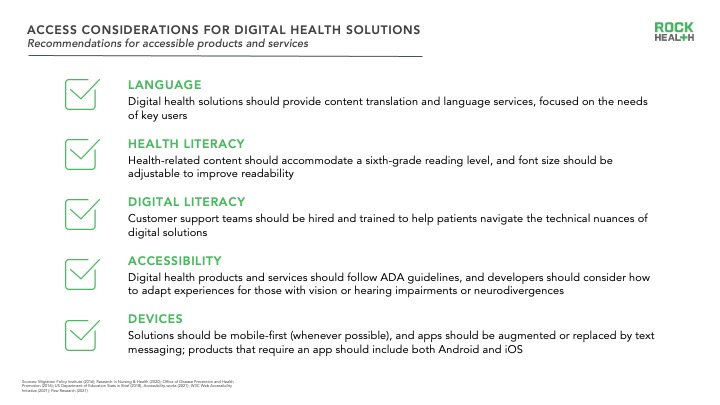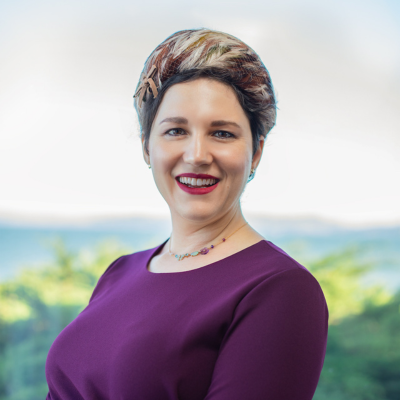Building toward equity: A working model for digital health
If the last few years are any indication, healthcare is embracing the promise of digital. Few things on this planet make our team more excited than the opportunities of digital health coming to fruition. However, as we celebrate digital health’s progress, we also see a long road ahead.
While healthcare is generally broken for the many, it is still uniquely broken for the few—particularly for those who are poor, for communities of color, and for others marginalized by the U.S. healthcare system. Despite its promise, digital health has the potential to leave some patients further behind by intertwining health disparities with barriers to internet access, device ownership, tech accessibility, and digital literacy.
In a future where care is increasingly delivered in digital ways, how do we ensure that health inequities aren’t compounded by digital divides?
Learning and Sharing
Health, justice, and technology leaders have done an incredible amount of work to both document and address healthcare and technology disparities, providing a solid foundation of institutional research and community-led perspectives. We at Rock Health feel a deep sense of appreciation for the blueprints they’ve created. Our mission is to make healthcare massively better for every human being—to do this, we must build our digital health research, investment, and strategy work upon the bedrock that these equity-minded leaders are establishing.
Our team has been listening to digital health leaders who place health equity at the center of their business models and have on-the-ground experience developing culturally responsive, accessible digital health solutions. Their insights have broadened our perspective and informed our approach. In our work with enterprises, startups, and other venture funds, we’ve been encouraged by a growing number of executives and product teams who are also seeking to better meet the needs of underserved and marginalized patients. Here we share what we’re learning from digital health equity leaders, in hopes that others in our digital health community will be inspired to develop more inclusive practices and products.
In this article, we outline key issues at the intersection of health and technology disparities and offer examples of how innovators are bridging the gaps. We also share a working framework for how product teams and business leaders can use digital health as a means to create a more equitable future.
A Tale of Two Divides
Research shows us that there are two interconnected forms of inequity that affect digital health: healthcare disparities and technology access disparities.
Healthcare disparities: Healthy People 2020 classifies health disparity as “a particular type of health difference that is closely linked with social, economic, and/or environmental disadvantage.” Healthcare disparities can include inequities in access as well as outcomes—both of which stem from a combination of societal factors.
- Healthcare access: Systemic and historical barriers to healthcare create avoidable, unequal variations in health outcomes as people delay or forgo care altogether. For example, Rock Health’s 2020 Consumer Adoption Report found that during the COVID-19 pandemic (as of October 2020), 53% of LGBTQ+ respondents delayed or avoided medical care compared to 41% of non-LGBTQ+-identifying respondents. Moreover, in spite of the recent and dramatic spike in telehealth adoption, distance still limits access to care for some communities. Geographic constraints and underfunded programs prevent many Native American and rural patients from accessing high-quality healthcare services.
- Healthcare outcomes: If and when historically excluded and underserved communities do access healthcare services, they often experience a system that is not designed for them. Many are impacted by discriminatory policies, mistreatment, and implicit bias based on their race, gender, or disability status. For example, research shows that Black individuals and women are less likely to receive proper treatment or be taken seriously by clinicians when they describe pain. Other patients are burdened by a lack of language and translation services, which can lead to dangerous communication gaps and clinical misunderstandings. Accounts of these disparities have become painfully familiar, especially in the midst of the pandemic. Overall life expectancy in the United States, for instance, declined in 2020 as a result of COVID-19. However, according to the CDC, this decline was significantly more pronounced for Black and Hispanic individuals.
Technology disparities: Health disparities are often exacerbated by barriers to technology access. For this reason, researchers have designated internet connectivity and digital literacies as the “super social determinants of health.” These barriers directly impact a person’s ability to access healthcare services or apply for employment, housing, and assistance programs. Technology disparities break down into three categories: connectivity, affordability, and accessibility.
- Connectivity: Despite widespread internet usage in the United States, 15–24% of Americans lack broadband connection, a foundational requirement for many digital health interventions. According to the Joint Center, that number jumps to 38% for African Americans who live in the Black Rural South (counties with populations that are 35% Black or higher). This lack of access requires patients to use public WiFi or prepaid plans, leaving them at risk of privacy breaches or data constraints.
- Affordability: Smartphones may appear to be a logical and adequate substitute for home internet; however, studies show that nearly 40% of adults ages 65 and over and roughly a quarter of low-income households do not own a smartphone, and many low-income individuals are forced to share smartphones with family or friends. Ownership barriers exist for other devices as well—only 58% of Black and 57% of Hispanic individuals own a desktop/laptop computer compared to 82% of White individuals.
- Accessibility: Many digital products do not account for varying levels of digital literacy, leading to unique challenges for older adults and individuals with disabilities. Because internet access does not equate to internet skills, researchers refer to technology literacy and usability as a “second-level digital divide.” Fortunately, some nonprofit and government organizations are working to provide user-friendly devices and training programs; however, inclusive product design is also required to close the gap.
A Path Forward
To build a more equitable healthcare future, the industry’s approach to digital health will need to fundamentally change. Fortunately, players in our sector are stepping up with new initiatives. Federally Qualified Health Centers (FQHC) and other community health centers are harnessing the power of telehealth solutions to improve access to quality care. Established healthcare organizations around the country are committing considerable funds to health equity programs, and national institutions are making public commitments to their workforces and communities. Other investors like Unseen Capital, Social Innovation Ventures, Town Hall Ventures, CHCF Health Innovation Fund, and Health Equity Ventures are investing in a group of diverse founders and equity-focused healthcare startups. There are also teams of mission-driven entrepreneurs launching companies such as Unite Us, ConsejoSano, Hoy Health, Patient Orator, Health in Her Hue, Hurdle, and Cayaba Care to meet the specific needs of underserved populations.
Framework for Equity-Centered Solution Development
Many healthcare organizations, however, are struggling to center equity within their digital health design, development, and deployment processes. In this spirit, we’ve put together a working model to encourage the development of culturally responsive and accessible digital health products and services. This model was shaped by numerous in-depth conversations with advocates, academics, enterprise leaders, and entrepreneurs focused on digital health equity. The framework below reflects their collective insights:
- Center in the community
- Co-design the solution
- Develop the right tech
- Make it accessible

Center in the community: Trusting relationships are foundational to health equity. However, in the wake of historic and present-day examples of mistreatment and exclusion, marginalized communities may experience hesitation surrounding health interventions and data sharing. For product builders to earn trust with a community, digital health equity leaders recommend building genuine and lasting relationships with established community institutions (e.g., faith-based organizations, local nonprofits, senior centers, athletic clubs, local businesses), as well as implementing community-based participatory design (CBPD) principles to create solutions with rather than for the community. Equity-minded product builders reinforce the idea that disparities are not an individual problem and require a collective solution. That requires demonstrating real respect for and partnership with social pillars in the community such as the local church, soccer club, or sorority.
“Everything is so local. You can design for a multicultural population in a relevant way, but the last piece of the solution requires on-the-ground connections with deep insight into the community experience. If you can’t have those local conversations and get organizations to work with each other—no one is going to trust the product. Those dynamics will make or break the success of a solution.”
– Taylor Justice, Co-Founder and President of Unite Us
Co-design the solution: At the end of the day, digital health is built by people. Culturally responsive and accessible products are best developed by diverse and inclusive teams who have firsthand community knowledge and lived experience. Research demonstrates that diverse teams tend to outperform homogenous ones, and digital health is no exception. As Yoona Kim, Co-Founder and CEO of Arine1, shared, “Our diverse team is critical to product design to ensure those we touch are served in a personalized way. Representation in-house impacts everything from scripting to product design to outreach.” Regardless of how diverse the backgrounds and experiences of a team may be, however, organizations should implement thoughtful user research, customer discovery, and co-design exercises to mitigate gaps in knowledge, expertise, and lived experience.
“Cultural competency is something that is ongoing and requires a willingness to constantly learn, and the humility to acknowledge and check one’s biases. We all have biases and if we’re not careful, they will show up in our work. We should always be asking: ‘Who has the expertise, perspectives, and experiences that I don’t have? How do I get them on my team to ensure my blindspots are covered?’”
– Ashlee Wisdom, Co-Founder and CEO of Health In Her Hue
Develop the right tech: Technology works best when it identifies the patterns of the people it is interacting with—their preferences, behavioral tendencies, and cultural backgrounds—and adapts to meet their needs. The same technology, algorithms, and devices that make personalization at scale possible, though, are often limited by bias in their datasets and calculative models. Bias has been detected in healthcare products and digital health solutions, such as computer-aided X-ray diagnosis and dermatology algorithms and datasets that perform worse for women and communities of color.
Diverse teams and representative user research can help reduce technology-embedded bias, but ongoing data collection and testing processes are also needed. As a first step, organizations can gather relevant race, ethnicity, and language data to inform product development. Abner Mason, Founder and CEO of ConsejoSano, says, “We can’t solve a problem that we can’t see. Healthcare organizations could leverage race, ethnicity, and language data to understand where and in what language to reach patients, who’s at risk, and how to step in. But none of that is possible if we fail to gather the data.” To promote transparency and engender trust, researchers recommend providing clear context about why patient data will be collected and committing to answer patients’ questions or concerns. As a next step, Harvard researchers recommend implementing bias checks throughout every stage of development and during post-launch assessments: “Bias can creep into the process anywhere in creating algorithms: from the very beginning with study design and data collection, data entry and cleaning, algorithm and model choice, and implementation and dissemination of the results.”
Make it accessible: Lastly, digital health teams need to ensure that solutions are accessible to a wide range of patient populations. The leaders we’ve spoken with recommend frequently asking, “Who is being left out?” as products are deployed and brought to market.
Inclusive access considerations include:
- Language: There are over 350 languages spoken in the United States, and 9% of the population five years or older self-reports speaking English less than “very well.” Digital health products should provide content translation and language services, focused on the language needs of key users.
- Health literacy: Nearly 90% of American adults have limited health literacy skills. Product content should be designed to accommodate a sixth-grade reading level, and font size should be adjustable to improve readability.
- Digital literacy: As many as 16% of U.S. adults are not digitally literate. Customer support teams should be trained to help patients navigate the technical nuances of digital solutions.
- Accessibility: Digital health products and services should follow ADA guidelines, and developers should consider how to adapt experiences for those with vision or hearing impairments or neurodivergences.
- Devices: While 97% of American adults own a cell phone, 15% do not have a mobile device with smartphone capabilities (e.g., data, apps). Whenever possible, mobile app features should be augmented (or replaced) by text messaging. As Abner Mason frequently shares: “Texting = health equity.” Solutions that do require a smartphone or app should include both Android as well as iOS to maximize the number of potential users.
“If you can avoid an app—don’t build one. Apps have not been created to be culturally or linguistically appropriate, so there has been a high level of disappointment for multicultural patients in the past. If you need an app, use a two-part strategy: (1) Use native SMS to build a relationship, and (2) direct them to the app via text and tell them why they should download it.”
– Abner Mason, Founder and CEO of ConsejoSano

Walking the Path Together
In a world of rapid technological advancement and slow social progress, the last thing we want for the industry is a broken, inequitable health system… repackaged in a digital way. Digital health alone cannot eliminate healthcare disparities or resolve the digital divide; however, thoughtful and inclusive approaches to product building can help make real headway.
At Rock Health, we’re encouraged by the blueprints that digital health equity leaders have created, and we’re motivated by the urgency of the problems yet to be solved. As we take imperfect but deliberate steps to center equity in our work, our goal is to share what we learn along the way.
There’s still a long road ahead. Culturally responsive and accessible digital health solutions will get us a step closer. The unified efforts of dedicated healthcare leaders will get us closer still. We at Rock Health are committed to doing this work in partnership with our community, and we’re honored to be on this journey together.
Stay tuned as we continue to share our learnings. In the meantime, please check out our research on diversity in digital health, LGBTQ+ digital health, and gender equity in healthcare.
Rock Health Advisory provides counsel on digital health strategy to innovators at enterprise companies through our consulting practice and membership program. For more information, reach out to advisory@rockhealth.com.
Rock Health.org equips innovators with the resources, reach, and recognition they need to create an equitable digital health future for all. To learn more, reach out to hello@rockhealth.org.
Rock Health’s venture fund invests in entrepreneurs bringing unique and innovative technology to healthcare. If you’re building a digital health company and looking for early-stage funding, we would love to hear from you. Get in touch!
Acknowledgements
We would like to offer special thanks to Abner Mason, Founder and CEO of ConsejoSano; Ashlee Wisdom, Co-Founder and CEO of Health In Her Hue; Taylor Justice, Co-Founder and President of Unite Us; and Yoona Kim, Co-Founder and CEO of Arine whose insights are included throughout the article. We also express gratitude to countless digital health equity leaders who shaped our thinking and shared their expertise, perspectives, and time with us.
Footnotes
1Arine is a Rock Health portfolio company.


